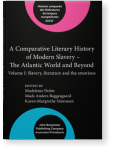Chapter 8
Before sentimental empire
Slavery, genre and emotion on the seventeenth-century French stage
This article seeks to historicize the eighteenth-century sentimental literature of slavery by
examining theatrical performances of cross-cultural servitude from an earlier, markedly different historical context,
that of seventeenth-century France. In contrast to the sentimental period, transatlantic empire was still more
aspiration than reality for France in the 1600s, slavery more a Mediterranean than an Atlantic phenomenon, and racial
discourse still in gestation. I demonstrate that the ways in which French seventeenth-century playwrights modeled
their audience’s emotional response to cross-cultural slavery evolved over time, moving from the possibility of
audience identification with enslaved characters to a foreclosure of that possibility. The mechanism for this tendency
to prevent identification is what I call generic drift, the migration of representations of servitude from the tragic
to the tragicomic and comic stages. To demonstrate the evolution of the theater’s modeling of emotional responses to
slavery from possible identification to the prevention of identification over time, I analyze representations of
servitude in Le More cruel, an anonymous tragedy from 1610, Scudéry’s 1636 tragicomedy
L’Amant liberal and Montfleury’s 1663–64 comedy Le Mary sans femme. I show that
the tragedy partially encourages the audience to feel compassion for the plight of the slave, whereas the tragicomic
and comic plays incite erotic pleasure or scorn, reactions that distance the audience from the enslaved. I also relate
the generic drift to the increased disciplining of compassion in the 1600s and to France’s growing participation in
the Atlantic slave trade.
Article outline
- Slavery in Le More cruel: Pity and fear in contradiction
- L’Amant libéral: Slavery as erotic spectacle
- Le Mary sans femme: Slavery ridiculed
- Generic drift and the racialization of slavery
-
Notes
-
References
This content is being prepared for publication; it may be subject to changes.
